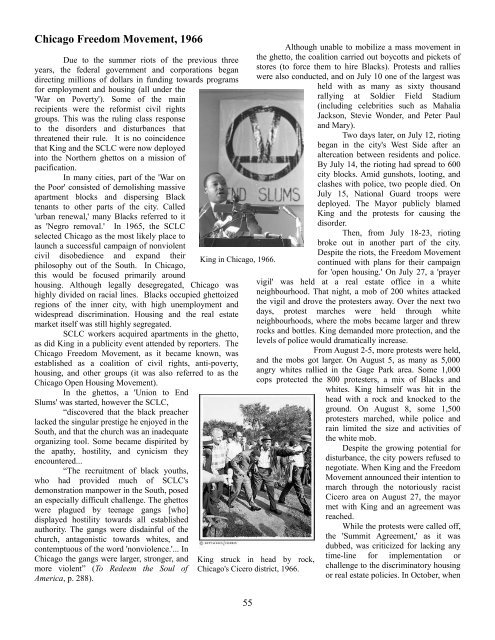smash-pacifism-zine
smash-pacifism-zine
smash-pacifism-zine
Create successful ePaper yourself
Turn your PDF publications into a flip-book with our unique Google optimized e-Paper software.
Chicago Freedom Movement, 1966<br />
Due to the summer riots of the previous three<br />
years, the federal government and corporations began<br />
directing millions of dollars in funding towards programs<br />
for employment and housing (all under the<br />
'War on Poverty'). Some of the main<br />
recipients were the reformist civil rights<br />
groups. This was the ruling class response<br />
to the disorders and disturbances that<br />
threatened their rule. It is no coincidence<br />
that King and the SCLC were now deployed<br />
into the Northern ghettos on a mission of<br />
pacification.<br />
In many cities, part of the 'War on<br />
the Poor' consisted of demolishing massive<br />
apartment blocks and dispersing Black<br />
tenants to other parts of the city. Called<br />
'urban renewal,' many Blacks referred to it<br />
as 'Negro removal.' In 1965, the SCLC<br />
selected Chicago as the most likely place to<br />
launch a successful campaign of nonviolent<br />
civil disobedience and expand their<br />
philosophy out of the South. In Chicago,<br />
this would be focused primarily around<br />
housing. Although legally desegregated, Chicago was<br />
highly divided on racial lines. Blacks occupied ghettoized<br />
regions of the inner city, with high unemployment and<br />
widespread discrimination. Housing and the real estate<br />
market itself was still highly segregated.<br />
SCLC workers acquired apartments in the ghetto,<br />
as did King in a publicity event attended by reporters. The<br />
Chicago Freedom Movement, as it became known, was<br />
established as a coalition of civil rights, anti-poverty,<br />
housing, and other groups (it was also referred to as the<br />
Chicago Open Housing Movement).<br />
In the ghettos, a 'Union to End<br />
Slums' was started, however the SCLC,<br />
“discovered that the black preacher<br />
lacked the singular prestige he enjoyed in the<br />
South, and that the church was an inadequate<br />
organizing tool. Some became dispirited by<br />
the apathy, hostility, and cynicism they<br />
encountered...<br />
“The recruitment of black youths,<br />
who had provided much of SCLC's<br />
demonstration manpower in the South, posed<br />
an especially difficult challenge. The ghettos<br />
were plagued by teenage gangs [who]<br />
displayed hostility towards all established<br />
authority. The gangs were disdainful of the<br />
church, antagonistic towards whites, and<br />
contemptuous of the word 'nonviolence.'... In<br />
Chicago the gangs were larger, stronger, and<br />
more violent” (To Redeem the Soul of<br />
America, p. 288).<br />
King in Chicago, 1966.<br />
55<br />
Although unable to mobilize a mass movement in<br />
the ghetto, the coalition carried out boycotts and pickets of<br />
stores (to force them to hire Blacks). Protests and rallies<br />
were also conducted, and on July 10 one of the largest was<br />
held with as many as sixty thousand<br />
rallying at Soldier Field Stadium<br />
(including celebrities such as Mahalia<br />
Jackson, Stevie Wonder, and Peter Paul<br />
and Mary).<br />
Two days later, on July 12, rioting<br />
began in the city's West Side after an<br />
altercation between residents and police.<br />
By July 14, the rioting had spread to 600<br />
city blocks. Amid gunshots, looting, and<br />
clashes with police, two people died. On<br />
July 15, National Guard troops were<br />
deployed. The Mayor publicly blamed<br />
King and the protests for causing the<br />
disorder.<br />
Then, from July 18-23, rioting<br />
broke out in another part of the city.<br />
Despite the riots, the Freedom Movement<br />
continued with plans for their campaign<br />
for 'open housing.' On July 27, a 'prayer<br />
vigil' was held at a real estate office in a white<br />
neighbourhood. That night, a mob of 200 whites attacked<br />
the vigil and drove the protesters away. Over the next two<br />
days, protest marches were held through white<br />
neighbourhoods, where the mobs became larger and threw<br />
rocks and bottles. King demanded more protection, and the<br />
levels of police would dramatically increase.<br />
From August 2-5, more protests were held,<br />
and the mobs got larger. On August 5, as many as 5,000<br />
angry whites rallied in the Gage Park area. Some 1,000<br />
cops protected the 800 protesters, a mix of Blacks and<br />
whites. King himself was hit in the<br />
head with a rock and knocked to the<br />
ground. On August 8, some 1,500<br />
protesters marched, while police and<br />
rain limited the size and activities of<br />
the white mob.<br />
Despite the growing potential for<br />
disturbance, the city powers refused to<br />
negotiate. When King and the Freedom<br />
Movement announced their intention to<br />
march through the notoriously racist<br />
Cicero area on August 27, the mayor<br />
met with King and an agreement was<br />
reached.<br />
While the protests were called off,<br />
the 'Summit Agreement,' as it was<br />
dubbed, was criticized for lacking any<br />
King struck in head by rock,<br />
Chicago's Cicero district, 1966.<br />
time-line for implementation or<br />
challenge to the discriminatory housing<br />
or real estate policies. In October, when



